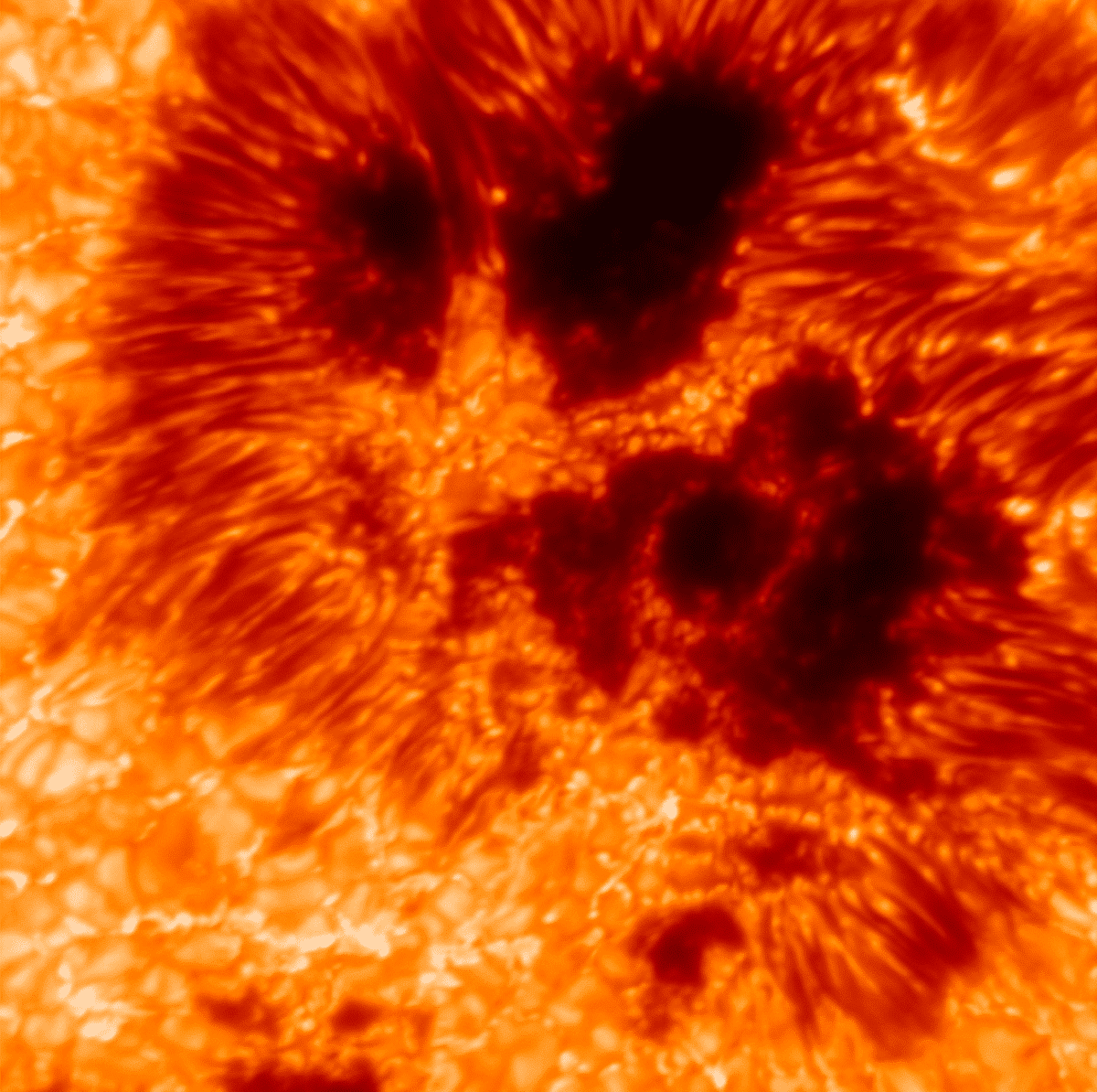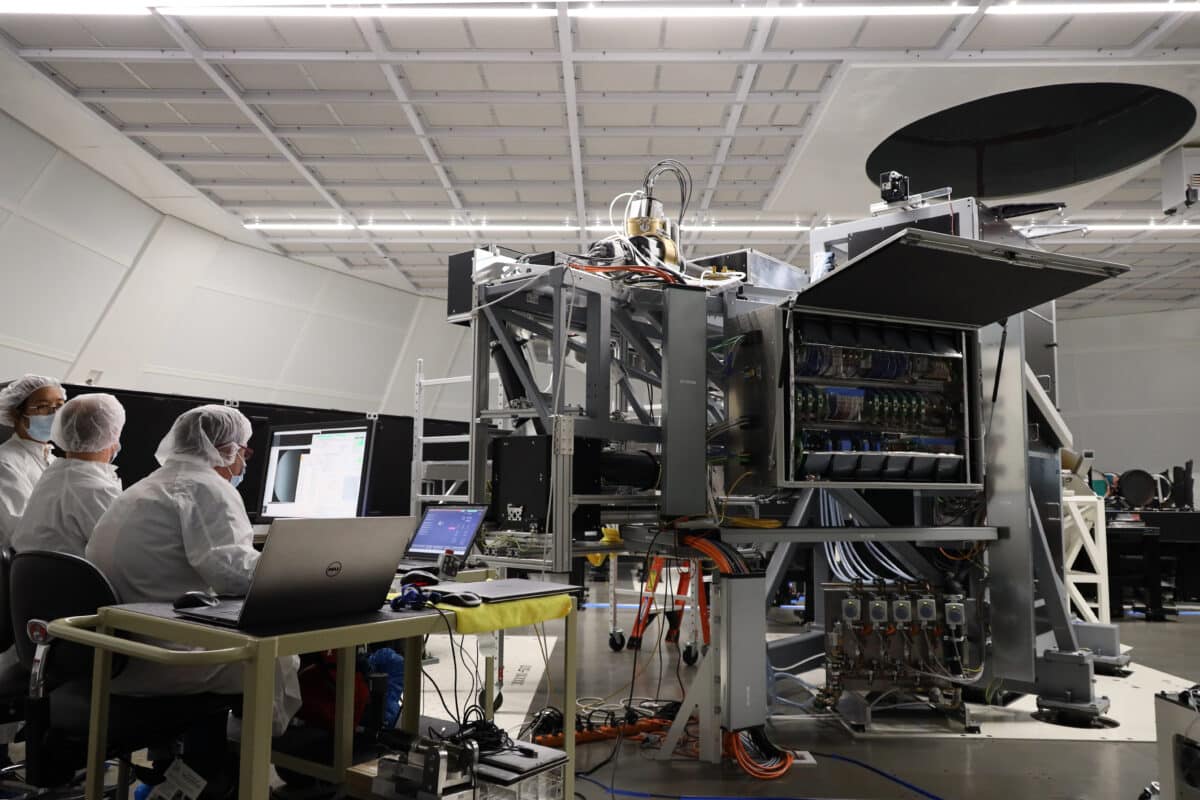
A narrow-band image of the Sun at a wavelength of λ=588.9nm, that of a well known solar sodium line also known as the “NaD line.” The image was acquired during recent first light efforts with the VTF at the Inouye, and shows how precisely the structures within a sunspot are resolved. Each pixel in the original version of the image corresponds to 10 km (or 6.2 miles) on the Sun. (Credit: VTF/KIS/NSF/NSO/AURA)
In a nutshell
- The Daniel K. Inouye Solar Telescope’s new Visible Tunable Filter (VTF) instrument has achieved “first light,” capturing detailed images of sunspots at an unprecedented 10km resolution.
- This revolutionary instrument measures specific wavelengths and light polarization to reveal the Sun’s magnetic fields, which are key to understanding and predicting dangerous solar storms.
- When fully operational, the VTF could help scientists forecast solar eruptions that can damage Earth’s power grids, communications networks, and satellites, potentially saving billions in infrastructure damage.
MAUI — After years of development, researchers at the Daniel K. Inouye Solar Telescope in Hawaii have fired up their newest tool, the Visible Tunable Filter (VTF), and captured its first images of our sun. This breakthrough gives scientists an unprecedented look at the invisible forces that drive dangerous solar eruptions.
“When powerful solar storms hit Earth, they impact critical infrastructure across the globe and in space. High-resolution observations of the sun are necessary to improve predictions of such damaging storms,” explains Dr. Carrie Black, program director for the NSF National Solar Observatory.
Most people rarely think about the Sun beyond checking the weather forecast, but our seemingly steady star regularly erupts with massive bursts of energy. When these solar storms hit Earth, they can knock out power grids, disrupt GPS navigation, and damage satellites, potentially causing billions in damage.
The World’s Most Powerful Solar Observatory
The Inouye Solar Telescope sits atop Hawaii’s Haleakalā volcano, where observational conditions are ideal. Its four-meter mirror (about 13 feet across) makes it the world’s largest instrument dedicated to studying our star.
Since 2022, it’s been capturing stunning images of the Sun that reveal features as small as 20 kilometers across – remarkable considering the Sun spans 1.4 million kilometers. The newly captured images from the VTF show sunspots with details down to just 10 kilometers per pixel.
“The significance of the technological achievement is such that one could easily argue the VTF is the Inouye Solar Telescope’s heart, and it is finally beating at its forever place,” says Dr. Matthias Schubert, VTF Project Scientist at the Leibniz Institute for Solar Physics (KIS), in a statement.

How It Works: Seeing the Invisible
The VTF weighs 5.6 tons and spans two floors — about the size of a small garage. Scientists at Germany’s Institute for Solar Physics spent about 15 years developing it, working in parallel with the telescope’s own construction.
The VTF functions as a specialized camera that can isolate specific colors of light coming from the Sun. While we see sunlight as white, it’s actually composed of countless individual wavelengths, each carrying unique information about solar conditions.
The instrument uses an etalon — a pair of precisely spaced glass plates separated by tens of microns — that allows it to tune through colors. By adjusting this spacing at the nanometer scale (i.e., as tiny as a billionth of a meter), the VTF sequentially scans different wavelengths, similar to taking a series of photographs using different color filters.
The VTF also measures how light waves oscillate, revealing the Sun’s magnetic fields – the driving force behind eruptions that can affect Earth. These capabilities allow researchers to measure the Sun’s temperature, pressure, velocity, and magnetic field strength at different altitudes in the solar atmosphere.

Protecting Earth From Solar Tantrums
The Sun is a plasma laboratory right on our doorstep. Everyone is familiar with aurorae, for instance, which show the influence of solar activity on Earth — a consequence of energy and small particles released by the Sun interacting with our planet’s magnetic field. Similar to weather forecasts on Earth, it should be possible to predict the geomagnetic disturbances caused by energy eruptions on the Sun.
The instrument peers into regions of the Sun where eruptions begin, the visible surface (photosphere) and the layer just above it (chromosphere). Here, hot plasma interacts with magnetic fields in ways scientists are still working to understand.

The need for better predictions grows more urgent as our dependence on technology increases. In 1989, a solar storm caused a nine-hour blackout in Quebec. Today, with our reliance on satellites, GPS, and interconnected power systems, a similar event could cause far more extensive disruption.
“The Inouye Solar Telescope was designed to study the underlying physics of the Sun as the driver of space weather. In pursuing this goal, the Inouye is an ideal platform for an unprecedented and pioneering instrument like the VTF,” said Christoph Keller, NSO Director.
“After all these years of work, VTF is a great success for me,” said Dr. Thomas Kentischer, KIS Co-Principal Investigator and key architect behind the instrument’s optical design. “I hope this instrument will become a powerful tool for scientists to answer outstanding questions on solar physics.”

While the first images show promising results, more work remains before the instrument is fully operational. Science verification and commissioning are expected to begin in 2026.







